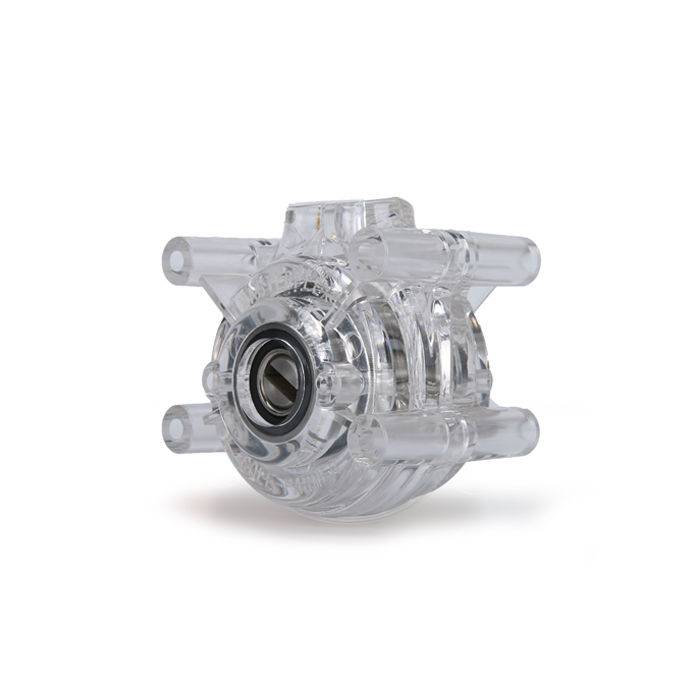Peristaltic pump is a kind of pump that transfers liquid by squeezing a hose or pipe, also known as a plunger pump; The fluid is isolated in the pump tube, the pump tube can be quickly replaced, the fluid can be retrograde, can be dry run, and the maintenance cost is low, which constitute the main competitive advantages of peristaltic pumps.
The composition of peristaltic pump
The peristaltic pump consists of three parts: the driver, the pump head and the hose. The fluid is isolated in the pump tube, the pump tube can be quickly replaced, the fluid can be retrograde, can be dry run, and the maintenance cost is low, which constitute the main competitive advantages of peristaltic pumps.
Working principle
A peristaltic pump is like squeezing a fluid filled hose with a finger clamp, and the fluid moves forward in the tube as the finger slides forward. The peristaltic pump is the same principle except that the roller replaces the finger. Fluid is pumped by alternately squeezing and releasing the pump’s elastic delivery hose. Just like squeezing a hose with two fingers, as the fingers move, negative pressure forms in the tube and the liquid flows with it. Peristaltic pump is a section of pump tube between two rollers to form a pillow shape fluid. The volume of the pillow depends on the inner diameter of the pump tube and the geometry of the rotor. The flow rate depends on the product of three parameters: the speed of the pump head, the size of the pillow, and the number of pillows produced by each turn of the rotor. The size of the pillow is generally constant (except when pumping fluids with particularly high viscosity). Compared with a pump with the same rotor diameter, a pump with a larger pillow volume has a larger fluid volume transported by the rotor per revolution, but the pulsation is also larger. This is similar to the case of membrane valves. The pump with a smaller pillow volume has a smaller volume of fluid transported by the rotor per turn. Moreover, the small pillow formed quickly and continuously makes the flow of fluid more stable.
Advantages of peristaltic pump
The advantages of peristaltic pump are as follows:
- No pollution: the fluid only contacts the pump pipe, not the pump body
- High accuracy: Repeat accuracy, high stability accuracy
- Low shear force: Ideal for transporting shear-sensitive, erosive fluids
- Good sealing: has good self-priming ability, can idling, can prevent backflow
- Easy maintenance: no valves and seals
- Conveying direction: with two-way equivalent flow conveying capacity
- Transportable items: can transport a variety of grinding, corrosion, oxygen sensitive materials and a variety of food;Select peristaltic pump head
Select peristaltic pump head
- Select pump head Select single or multi-channel fluid transfer
- Easy to replace hose
- Whether it is easy to fix the hose pressure pipe clearance and fine-tune it by ratchet or other means to accommodate different wall thickness hoses or to achieve fine tuning of the pressure

Select peristaltic pump tube
Basic conditions of peristaltic pump tube:
- It has certain elasticity, that is, the hose can quickly recover its shape after radial pressure
- It has certain wear resistance
- Have some ability to work under pressure
- No leakage (good air tightness)
- Low adsorption, good temperature resistance, not easy to age, no swelling, corrosion resistance, low precipitates
Application of peristaltic pump
Peristaltic pumps are typically used to pump clean/sterile or aggressive fluids without exposing these fluids to contamination from exposed pump components. Some common applications include:
- Fluids are pumped through infusion equipment, monosampling blood separations, aggressive chemicals, high solid content slurries and other materials where isolation of the product from the environment and the environment from the product is critical. Since the pump does not cause significant hemolysis, it is also used in heart-lung machines to circulate blood during bypass surgery as well as in hemodialysis systems.
- Peristaltic pumps are also widely used in a variety of industrial applications, especially in agriculture, as they are well suited to common agricultural chemicals.